Modeling and Research on the Defects of Pressed Rigging in a Geomagnetic Field Based on Finite Element Simulation
Abstract
1. Introduction
2. Finite Element Simulation of Force–Magnetic Coupling Based on a Geomagnetic Field
2.1. Software Overview
2.2. Finite Element Simulation Process
2.3. Drawing of Three-Dimensional Pressed Rigging Model
2.4. Static Structural Analysis
2.4.1. Material Composition and Properties
2.4.2. Division of Element Mesh
2.4.3. Model Boundary Conditions and Loading Method
2.5. Simulation of Geomagnetic Field
2.5.1. Geomagnetic Field Configuration
2.5.2. Simulation Calculation of Pressed Rigging Force–Magnetic Coupling
3. Finite Element Analysis Results
3.1. Static Analysis Results
3.2. Geomagnetic Simulation Analysis Results
4. Experimental Verification of Finite Element Simulation Results
4.1. Equipment Model and Verification Materials
4.2. Verification Experiment
5. Discussion
6. Conclusions
- According to the software model simplification principle of ANSYS and ANSYS Electronics Suite, the 6 × 34 strand wire rope model was simplified to 6 × 7 strand wire rope model, which can not only shorten the calculation time, but also improve the calculation efficiency, under the condition of a small error being created.
- The simulation calculation with ANSYS simulation software shows that, under the action of a transverse force, the internal stress generated by pressed rigging with defects in a geomagnetic field will change the magnetic field around the pressed rigging. With the gradual increase in the rigging’s internal stress, the magnetic induction intensity will increase and then decrease.
- Through simulation with ANSYS and ANSYS Electronics Suite, it can be found that the force–magnetic coupling analysis method can accurately calculate that the magnetic induction intensity of defective pressed rigging in a geomagnetic field decreases with the increase in the radial distance of the rigging under the action of a transverse force.
- The test results of the geomagnetic flaw detection equipment show that when the defect length of the pressed rigging is 5 mm, the difference between the peak and the trough of the magnetic induction intensity at the defect of the pressed rigging is about 9 mT, and, when the defect length of the pressed rigging is the same, the difference between the peak and trough of magnetic induction intensity calculated by ANSYS simulation is consistent with the result measured by the geomagnetic flaw detection equipment.
Author Contributions
Funding
Data Availability Statement
Conflicts of Interest
References
- Hu, D.F.; Zhang, J.M.; Bu, Q.B.; Tian, B.H.; Chen, X.Z.; Wang, K. Technical measures for non-destructive testing of amplitude-varying wire ropes on offshore oil engineering lifting vessels. Chem. Eng. Manag. 2024, 11, 66–68. (In Chinese) [Google Scholar]
- Guo, Z.H.; Jia, R.R.; Yang, S.P.; Li, G.H.; Huang, K.J.; Peng, L. Non-destructive testing of wire ropes based on weak magnetic field measurement. Phys. Exp. 2022, 42, 34–39. (In Chinese) [Google Scholar]
- Feng, B.; Wu, J.; Tu, H.; Tang, J.; Kang, Y. A review of magnetic flux leakage nondestructive testing. Materials 2022, 15, 7362. [Google Scholar] [CrossRef] [PubMed]
- Wang, H.; Jie, T.; Li, X.; Lv, X. Inspection of mine wire rope using magnetic aggregation bridge based on magnetic resistance sensor array. IEEE Trans. Instrum. Meas. 2020, 69, 7437–7448. [Google Scholar] [CrossRef]
- Jomdecha, C.; Prateepasen, A. Design of modified electromagnetic main-flux for steel wire rope inspection. NDT E Int. 2009, 42, 77–83. [Google Scholar] [CrossRef]
- Sablik, M.J.; Geerts, W.J.; Smith, K.; Gregory, A.; Moore, C.; Palmer, D.; Bandyopadhyay, A.; Landgraf, F.J.G.; de Campos, M.F. Modeling of plastic deformation effects in ferromagnetic thin films. IEEE Trans. Magn. 2010, 46, 491–494. [Google Scholar] [CrossRef]
- Jiles, D.C. Theory of the magnetomechanical effect. J. Phys. D Appl. Phys. 1995, 28, 1537. [Google Scholar] [CrossRef]
- Yang, S.; Moon, K.W.; Ju, T.S.; Kim, C.; Park, S.; Hwang, C. Universality of stripe domain width change by an in-plane magnetic field. J. Magn. Magn. Mater. 2021, 539, 168381. [Google Scholar] [CrossRef]
- Quondam Antonio, S.; Fulginei, F.R.; Lozito, G.M.; Faba, A.; Salvini, A.; Bonaiuto, V.; Sargeni, F. Computing Frequency-Dependent Hysteresis Loops and Dynamic Energy Losses in Soft Magnetic Alloys via Artificial Neural Networks. Mathematics 2022, 10, 2346. [Google Scholar] [CrossRef]
- Olabi, A.G.; Grunwald, A. Design and application of magnetostrictive materials. Mater. Des. 2008, 29, 469–483. [Google Scholar] [CrossRef]
- Dapino, M.J. On magnetostrictive materials and their use in smart material transducers. Struct. Eng. Mech. J. 2002, 17, 1–28. [Google Scholar]
- Li, G.Y. Research on Non-Destructive Testing Technology for Wire Ropes Based on Electromagnetic Method. Master of Thesis, Beijing University of Posts and Telecommunications, Beijing, China, 2014. [Google Scholar]
- Ding, Y.F. Research on Wire Rope Detection Based on Electromagnetic Testing Method. Master of Thesis, Beijing University of Posts and Telecommunications, Beijing, China, 2011. [Google Scholar]
- Zhang, J.; Peng, F.; Chen, J. Quantitative detection of wire rope based on three-dimensional magnetic flux leakage color imaging technology. IEEE Access 2020, 8, 104165–104174. [Google Scholar] [CrossRef]
- Chen, Q.; Zhang, J.; Li, B. Finite element simulation and test of metal magnetic memory detection of wire rope under weak magnetic field. J. Fail. Anal. Prev. 2023, 23, 351–360. [Google Scholar] [CrossRef]
- Zhao, M.; Zhang, D.L. Finite element simulation of leakage magnetic field of typical wire rope defects. Nondestruct. Test. 2009, 31, 177–180. (In Chinese) [Google Scholar]
- Du, W.; Ma, B.; Xie, Z.; Cao, D.; Wu, P. Finite element analysis on the wire breaking rule of 1×7IWS steel wire rope. EDP Sci. 2017, 108, 01002. [Google Scholar]
- Chen, Y.; Meng, F.; Gong, X.S. Parametric modeling and comparative finite element analysis of spiral triangular strand and simple straight strand. Adv. Eng. Softw. 2015, 90, 63–75. [Google Scholar] [CrossRef]
- Chen, X.Y.; Zhang, J.; Tang, W.T. Finite element simulation of 1×7+IWS structure wire rope in service. Foundry Technol. 2014, 35, 676–678. (In Chinese) [Google Scholar]
- Lian, Z. Research on the Mechanism of Pipeline Stress Detection Based on Strong and Weak Magnetic Coupling Method. Master’s Thesis, Shenyang University of Technology, Shenyang, China, 2022. [Google Scholar]
- Zhao, Y.H. Research on Pipeline Stress Detection Method Based on Strong and Weak Magnetic Coupling Technology. Master’s Thesis, Shenyang University of Technology, Shenyang, China, 2022. [Google Scholar]
- Zheng, S.M. Research on Magneto Mechanical Relationship Based on Improved J-A Model. Master’s Thesis, Shenyang University of Technology, Shenyang, China, 2022. [Google Scholar]
- Kastratović, G.; Vidanović, N. 3D finite element modeling of sling wire rope in lifting and transport processes. Transport 2015, 30, 129–134. [Google Scholar] [CrossRef][Green Version]
- Zhang, D.; Feng, C.; Chen, K.; Wang, D.; Ni, X. Effect of broken wire on bending fatigue characteristics of wire ropes. Int. J. Fatigue 2017, 103, 456–465. [Google Scholar] [CrossRef]
- Kastratović, G.; Vidanović, N.; Bakić, V.; Rašuo, B. On finite element analysis of sling wire rope subjected to axial loading. Ocean. Eng. 2014, 88, 480–487. [Google Scholar] [CrossRef]
- Delin, S. Mechanical Properties of Metals, 1st ed.; China Machine Press: Beijing, China, 1987; pp. 15–33. [Google Scholar]
- Peng, Y.; Huang, K.; Ma, C.; Zhu, Z.; Chang, X.; Lu, H.; Zhang, Q.; Xu, C. Friction and wear of multiple steel wires in a wire rope. Friction 2023, 11, 763–784. [Google Scholar] [CrossRef]
- Ai, L.S.J. Research and Analysis of Magnetic Properties of Broken Wire Detection in Wire Ropes Based on Weak Magnetic Field. Master’s Thesis, Wuhan University of Technology, Wuhan, China, 2009. [Google Scholar]
- He, J.; Wu, B.; Wu, N.; Chen, L.; Chen, A.; Li, L.; Xiong, Z.; Lin, J. Numerical and Theoretical Investigation on the Load-Carrying Capacity of Bolted Ball-Cylinder Joints with High-Strength Steel at Elevated Temperatures. Metals 2022, 12, 597. [Google Scholar] [CrossRef]
- Gerdemeli, I.; Kurt, S.; Anil, A.S. Fatigue life analysis of wire rope strands with finite element method. Key Eng. Mater. 2014, 572, 513–516. [Google Scholar] [CrossRef]
- He, Y.; Cheng, T.; Li, Z.; Li, C. Application of electromagnetic method in magnetic memory testing of buried pipelines. China Saf. Sci. J. 2019, 29, 122–127. (In Chinese) [Google Scholar]
- Kokornaczyk, E.; Gutowski, M.W. Anhysteretic Functions for the Jiles–Atherton Model. IEEE Trans. Magn. 2015, 51, 7300305. [Google Scholar] [CrossRef]
- Hamel, M.; Nait Ouslimane, A.; Hocini, F. A study of Jiles-Atherton and the modified arctangent models for the description of dynamic hysteresis curves. Phys. B Condens. Matter 2022, 638, 413930. [Google Scholar] [CrossRef]
- Xue, G.M.; Bai, H.B.; Li, T.; Ren, Z.Y. Numerical Solving Method for Jiles-Atherton Model and Influence Analysis of the Initial Magnetic Field on Hysteresis. Mathematics 2022, 10, 4431. [Google Scholar] [CrossRef]
- Hoffmann, K.; Bastos, J.P.A.; Leite, J.V.; Sadowski, N.; Barbosa, F. A vector Jiles–Atherton model for improving the FEM convergence. IEEE Trans. Magn. 2017, 53, 7300304. [Google Scholar] [CrossRef]
- Kim, S.; Kim, K.; Choe, K.; JuHyok, U.; Rim, H. A nonlinear magneto-mechanical coupling model for magnetization and magnetostriction of ferromagnetic materials. AIP Adv. 2020, 10, 085304. [Google Scholar] [CrossRef]
- Ma, J.; Ge, S.; Zheng, D. Distribution of wire deformation within strands of wire ropes. J. China Univ. Min. Technol. 2008, 18, 475–478. [Google Scholar] [CrossRef]

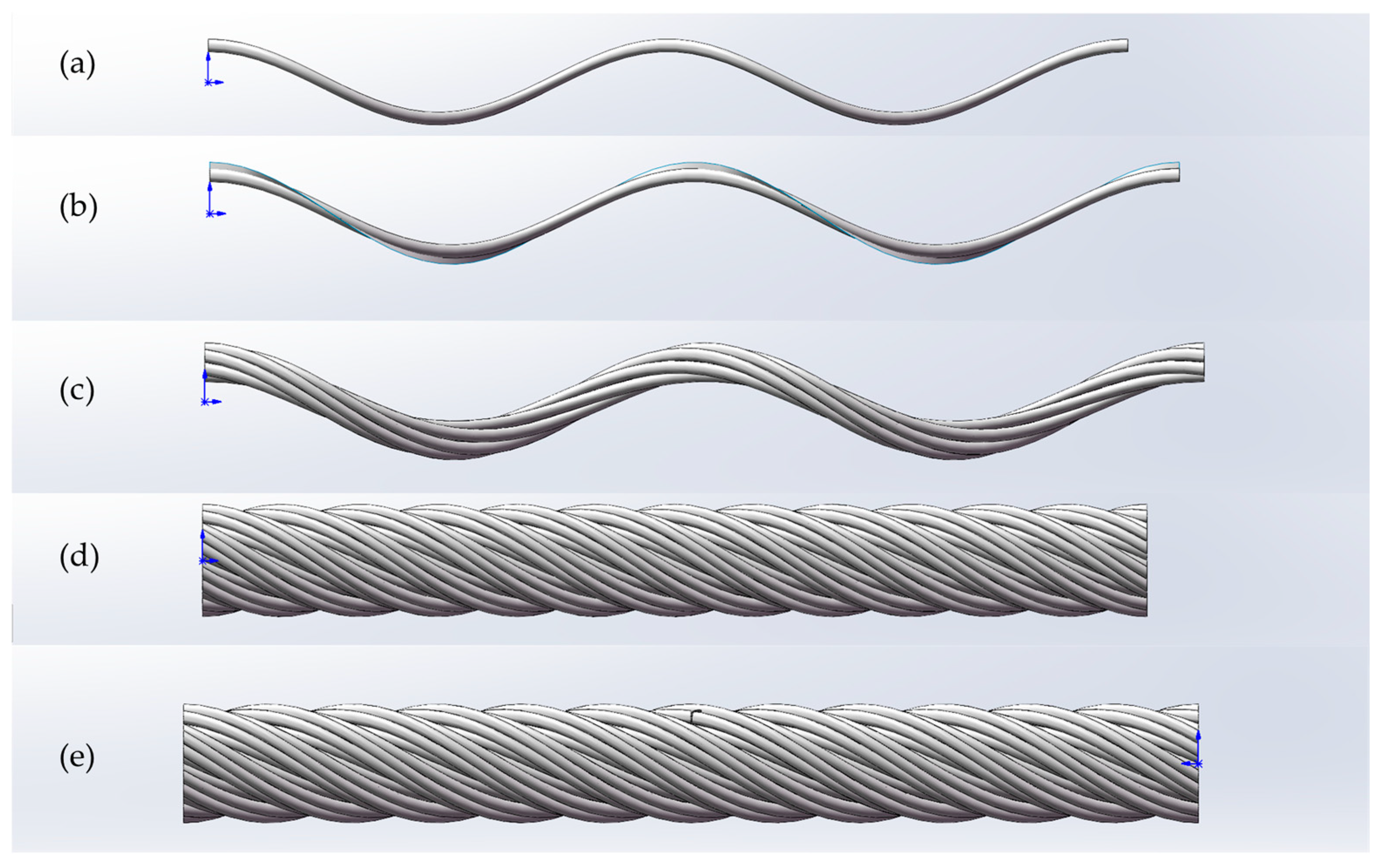

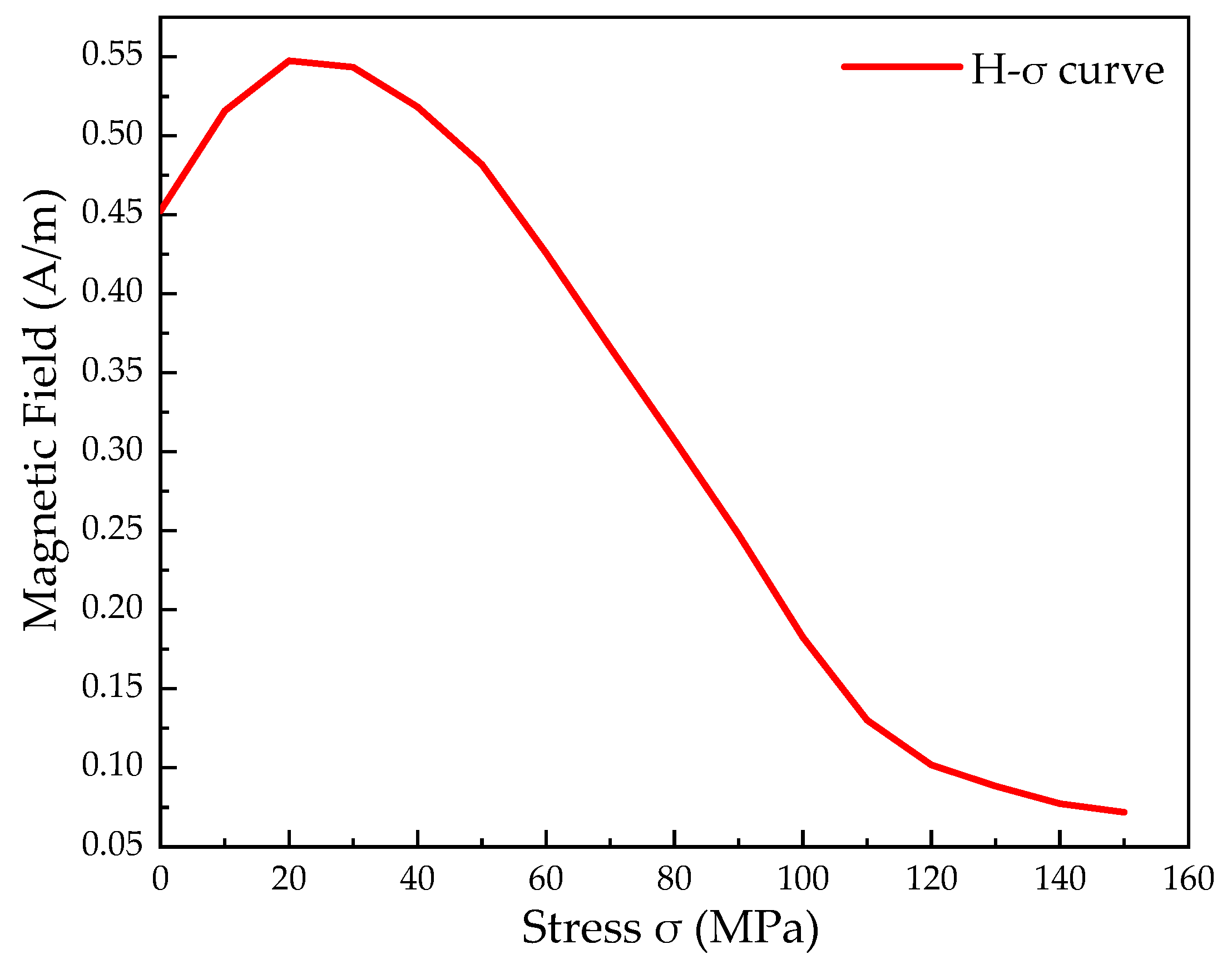
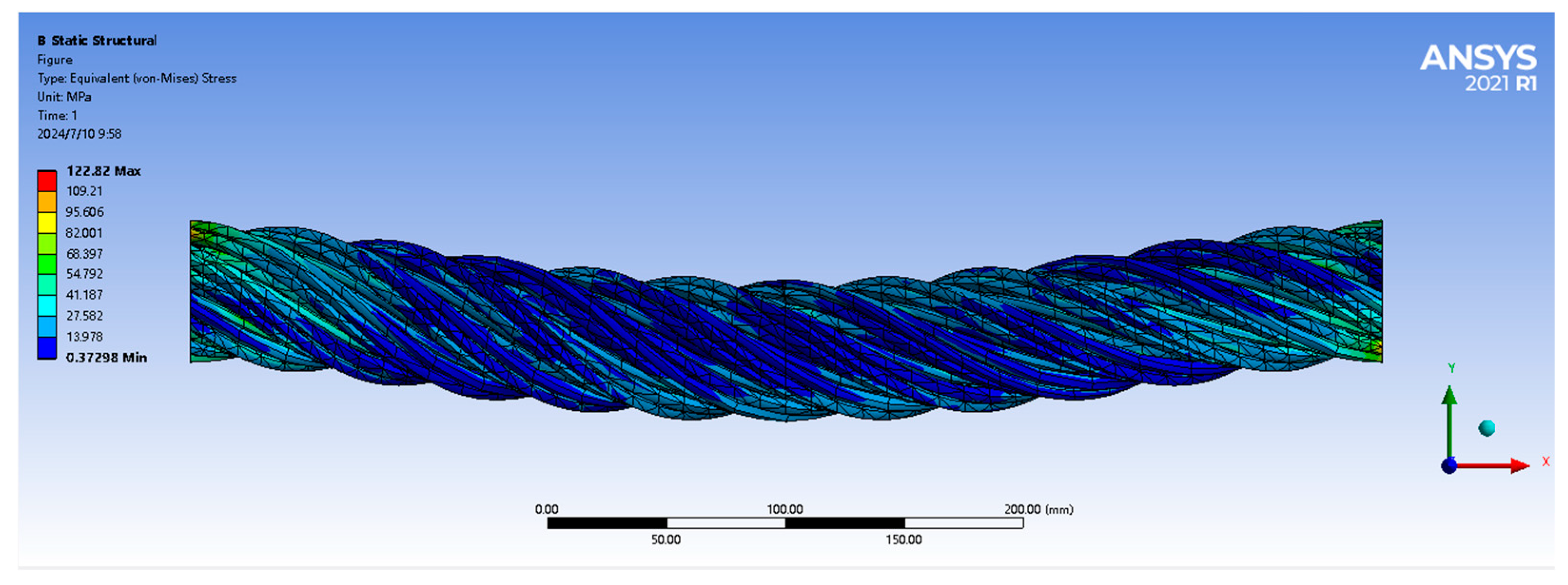
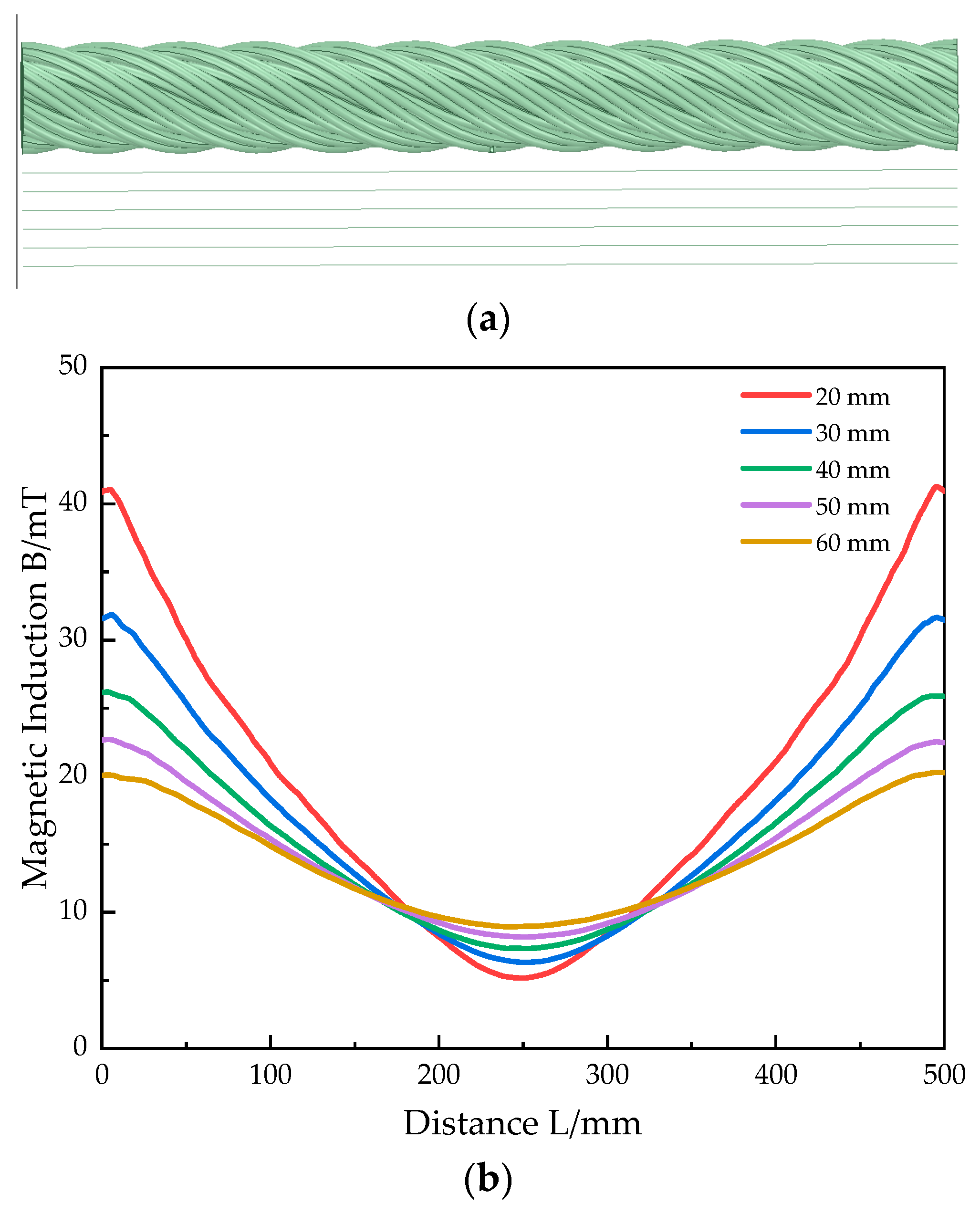
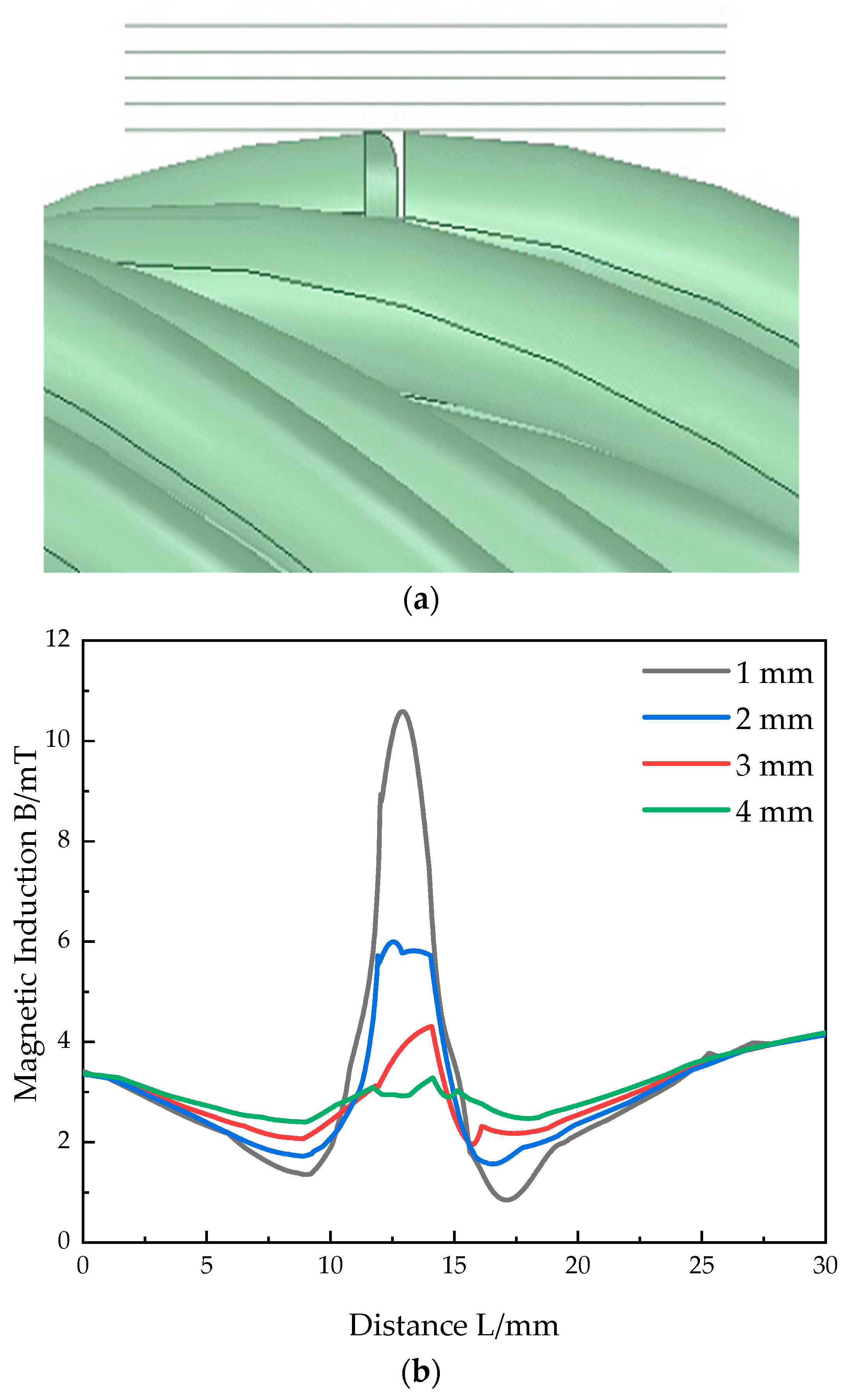


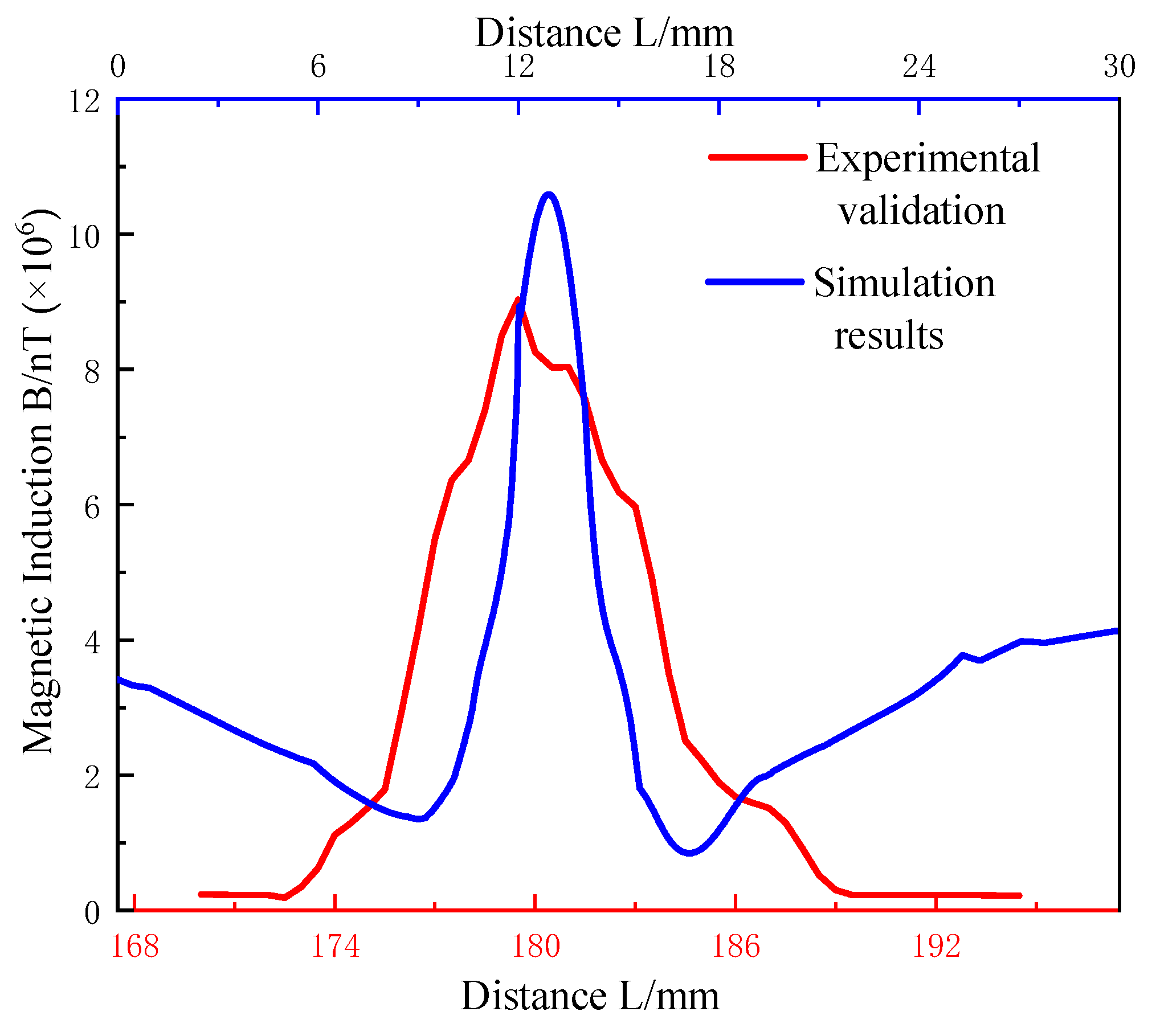
| Material Property | Value |
|---|---|
| Young’s Modulus E/GPa | 210 |
| Poisson’s Ratio γ | 0.27 |
| Standard Tensile Strength σb/MPa | 345 |
| Yield Strength σs/MPa | 20 |
| Elastic Modulus E/GPa | 210 |
| Coefficient of Friction μ | 0.3~0.6 |
| Density ρ/(kg·m3) | 7.85 × 103 |
| Parameter | Numerical Value |
|---|---|
| () | |
| () | |
| () | 500 |
| () | 180 |
| () | 207 |
| () | |
| () | |
| () | |
| () |
Disclaimer/Publisher’s Note: The statements, opinions and data contained in all publications are solely those of the individual author(s) and contributor(s) and not of MDPI and/or the editor(s). MDPI and/or the editor(s) disclaim responsibility for any injury to people or property resulting from any ideas, methods, instructions or products referred to in the content. |
© 2024 by the authors. Licensee MDPI, Basel, Switzerland. This article is an open access article distributed under the terms and conditions of the Creative Commons Attribution (CC BY) license (https://creativecommons.org/licenses/by/4.0/).
Share and Cite
Zhao, G.; Han, C.; Yu, Z.; Zhang, H.; Zhao, D.; Yu, G.; Jiang, Z. Modeling and Research on the Defects of Pressed Rigging in a Geomagnetic Field Based on Finite Element Simulation. Metals 2024, 14, 811. https://doi.org/10.3390/met14070811
Zhao G, Han C, Yu Z, Zhang H, Zhao D, Yu G, Jiang Z. Modeling and Research on the Defects of Pressed Rigging in a Geomagnetic Field Based on Finite Element Simulation. Metals. 2024; 14(7):811. https://doi.org/10.3390/met14070811
Chicago/Turabian StyleZhao, Gang, Changyu Han, Zhongxiang Yu, Hongmei Zhang, Dadong Zhao, Guoao Yu, and Zhengyi Jiang. 2024. "Modeling and Research on the Defects of Pressed Rigging in a Geomagnetic Field Based on Finite Element Simulation" Metals 14, no. 7: 811. https://doi.org/10.3390/met14070811
APA StyleZhao, G., Han, C., Yu, Z., Zhang, H., Zhao, D., Yu, G., & Jiang, Z. (2024). Modeling and Research on the Defects of Pressed Rigging in a Geomagnetic Field Based on Finite Element Simulation. Metals, 14(7), 811. https://doi.org/10.3390/met14070811






